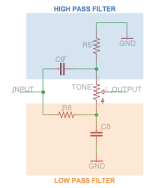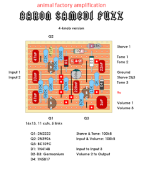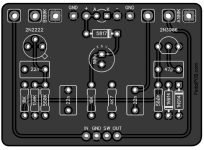@Feral Feline Much appreciated, and this is kind of what I deduced after seeing it so many times. I'll certainly check out The Secret Life Of Pots. It sounds like when you use a pot (or trimpot) as a rheostat you only really
need two lugs, but the third one is there for either protection or grounding..? I feel like maybe I'm oversimplifying...
It's still confusing why it really didn't matter whether I connected the lug with the 47k resistor to the top or bottom pad of what used to be the 470k resistor. I figured there was a very specific order things had to flow, but it sounds like as long as the 47k was connected to one of the lugs and one of the pcb pads, it was going to do it's job.
Possibly the same situation for connecting the middle pot lug to either the top or bottom "470k pad" on the pcb and a side lug to the other pad - it sounded like there was no "wrong" way to do it - unless I misinterpreted something! I'm still a dum-dum, my apologies. Been doing this two months. I
do know that whatever side lug I use determines the CW/CCW effect of that control. So I guess I'm learning
something...

for either protection or grounding..?
Well, only grounding if that's the primary function of the rheostat, to control/limit the path-flow to ground. Otherwise you've got yourself a voltage divider again.
As for order, sometimes things matter, some don't:
It's still confusing why it really didn't matter whether I connected the lug with the 47k resistor to the top or bottom pad of what used to be the 470k resistor.
Where you put the 47k in this case doesn't matter, the path with/without the rheostat will still have the 47k in it. Now add the rheostat at precisely half its 500k value:
250k + 47k = 297k
47k + 250k = 297k
Like an LED's CLR (current limiting resistor), it doesn't matter if you have a 4k7 on the cathode or on the anode of your bypass LED so long as the current gets some resistance somewhere along the current, or you'll blow the LED with 9v supply.
Back to rheostats and where they make a difference. Take a look at the humble Muff Tone control (graphic courtesy of Coda's website):

The resistors R5 and R8 are each forming a respective voltage divider in conjunction with the Tone Pot — add in the caps and you've got very different functions namely the HPF and LPF. Let's mod out that R5 above with the
AMZ Presence Control...
R5 is now in series with a 25k rheostat, so it still doesn't matter whether the 3k3 is before or after the rheostat, but in relation to C9 (12n) the flow matters — swap C9 and the 28k3 R5 collective and you've got another LPF in addition to the one formed by 39k and 10n (R8/C8).
Kit Rae has the AMZ version and another mids mod in this schematic
on his site:
I tend to go overboard with examples...
I assure you it's only myself I'm flogging, to reinforce within me what I've learned to regurgitate in hopes I'll actually truly assimilate the knowledge and not have to relearn it later.
Like when ...
I re-read "Secret Life of Pots", I've learned more elsewhere and that helps me gain deeper knowledge and meaning each time
I re-read "Secret Life of Pots"... is there an echo in here?
After first starting building, you've already accomplished more in two months than it took me two years to achieve.
I digress, because I'm good at it.








